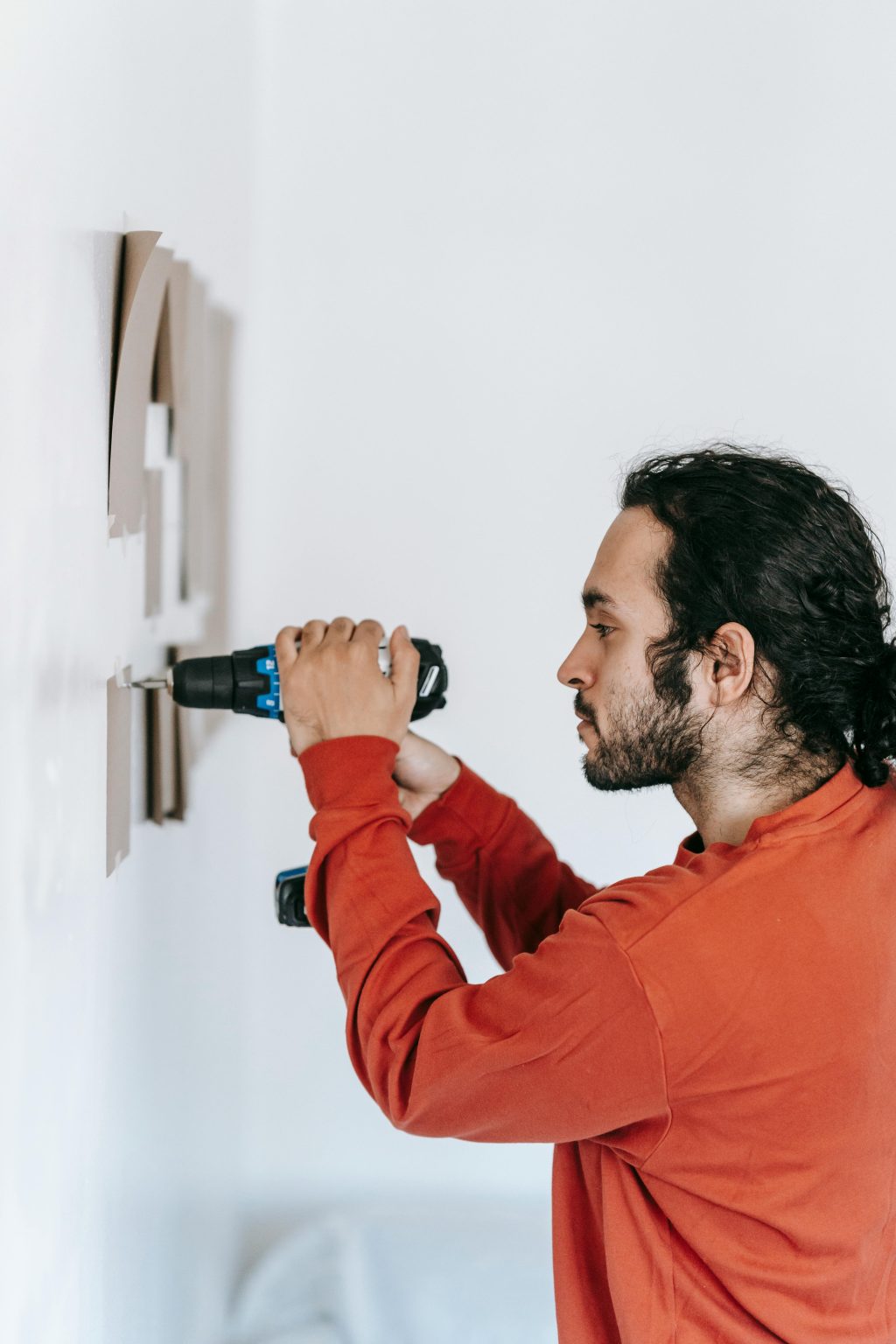Feature walls are having a moment. From bold botanical wallpapers to rich wood panelling, these statement walls can transform any room into something special. But here’s the thing — mounting a TV on one of these beauties is like performing surgery on a work of art. Get it wrong, and you’ve just turned your showpiece into a disaster zone.
I’ve seen too many gorgeous feature walls ruined by hasty TV installations. Wonky brackets, visible cables snaking everywhere, and worst of all — holes drilled in all the wrong places. It’s heartbreaking, honestly.
The good news? With proper planning & the right approach, you can have your cake and eat it too. Your TV can complement your feature wall rather than compete with it. Sometimes the simplest solutions are the most elegant ones.
Planning Your TV Placement Like a Pro
Before you even think about picking up that drill, take a step back. Literally. Stand in your usual viewing spot and really look at your feature wall. What’s the natural focal point? Is there a pattern you need to work around?
Measure twice, drill once — that old carpentry saying couldn’t be more relevant here. Your TV should sit at eye level when you’re seated, which is typically 42-48 inches from the floor to the centre of the screen. But here’s where it gets tricky with feature walls.
If you’ve got vertical stripes or panelling, your TV needs to align with these lines. Horizontal patterns? Same rule applies. The goal is to make your TV look like it was always meant to be there, not like an afterthought someone slapped on the wall.
Consider the room’s lighting too. That gorgeous textured wallpaper might create shadows that interfere with your viewing experience. I learned this the hard way when I helped my neighbour mount his 55-inch monster on a heavily textured wall — the shadows made watching anything a nightmare.
Choosing the Right Mounting Hardware
Not all wall mounts are created equal, especially when you’re dealing with feature walls. Standard drywall anchors might work for painted walls, but decorative panelling or thick wallpaper changes everything.
For wallpapered walls, you’ll want to use proper wall studs whenever possible. The paper and adhesive add thickness, which can affect how securely your mount sits. Plus, you don’t want the weight of your TV pulling at the wallpaper edges.
Panelled walls present their own challenges. Depending on the panel thickness, you might need longer screws or specialised fixings. Some panels are purely decorative (think thin MDF over drywall), while others might be structural. Know what you’re working with before you start.
Tilting mounts can be your friend here. They allow you to adjust the angle slightly, which is handy if your feature wall has texture that affects viewing angles. Fixed mounts look cleaner, but they’re less forgiving if you get the positioning slightly wrong.
The Art of Hiding Cables
Nothing ruins a feature wall faster than a tangle of cables. Seriously, you could have the most gorgeous William Morris wallpaper, but if there are cables everywhere, that’s all anyone will see.
Cable management starts with planning your power source. Ideally, you want sockets positioned behind where your TV will sit. If you’re renovating, this is the time to think about it. Retro-fitting power sockets later is possible but messier.
For existing installations, cable covers are your best friend. Choose ones that match your wall colour or, better yet, get ones you can paint or wallpaper over. They’re not invisible, but they’re infinitely better than loose cables.
In-wall cable routing is the gold standard, but it’s not always feasible with feature walls. Thick wallpaper can make it tricky, and some panelling installations don’t allow for it. Sometimes you have to compromise — and that’s okay.
Working with Different Feature Wall Materials
Wallpaper demands a delicate touch. That expensive Sanderson print won’t forgive rough handling. Use a sharp craft knife to make precise cuts, and always cut from the back when possible. Peel back small sections rather than tearing through.
Wood panelling varies wildly in installation methods. Some panels are glued directly to the wall, others are mounted on battens. This affects where you can safely drill and what fixings you’ll need. If you’re unsure, it’s worth having someone experienced take a look.
Painted feature walls might seem straightforward, but matching paint for touch-ups can be surprisingly difficult. Even the same paint can look different depending on when it was applied and how it’s aged. Keep some paint aside for repairs — you’ll thank yourself later.
Textured walls like exposed brick or stone create their own challenges. The uneven surface makes it difficult to get a flush mount, and drilling into natural stone requires specific techniques and tools. Frankly, these might be best left to the professionals.
Common Mistakes That Ruin the Aesthetic
The biggest mistake I see? Treating feature walls like regular painted walls. They’re not. Each material has its quirks, and ignoring them leads to problems.
Rushing the job is another classic error. Feature walls take time to get right. You’re not just mounting a TV — you’re integrating it into a design scheme. This isn’t a quick Saturday morning project.
Using inappropriate fixings is surprisingly common. Those toggle bolts that work great on drywall? They might not be suitable for your panelled wall. And don’t get me started on people who use rawl plugs for everything — they’re not a universal solution.
Ignoring the room’s proportions is another pitfall. A massive TV on a delicate feature wall looks ridiculous, like wearing hiking boots with a evening dress. The scale needs to work together.
When to Call in Professional Help
Some jobs are definitely DIY-friendly, but others? Not so much. If you’re dealing with expensive wallpaper, complex panelling, or structural walls, it might be worth getting professional help.
A feature wall is a statement, and a poorly mounted TV can ruin the effect. Precision is key. When my sister had her living room redecorated, she was worried about drilling into the new panelling. She hired James Wilson, and their team did a flawless job, perfectly integrating the TV without compromising the design. It’s a testament to their attention to detail.
Electrical work is another area where professionals earn their keep. Adding new power sockets or extensive cable routing often requires someone qualified. It’s not worth risking your beautiful feature wall (or your safety) to save a few pounds.
Complex mounting situations — like curved walls or unusual materials — also benefit from professional expertise. They have the right tools and experience to handle tricky installations without damaging your decor.
Maintaining Your Feature Wall After Installation
Once your TV is mounted, your feature wall still needs care. Dust settles differently around electronics, and the heat from your TV can affect certain materials over time.
Regular gentle cleaning keeps wallpaper looking fresh. Avoid harsh chemicals or excessive moisture — both can damage the paper or adhesive. A soft brush or vacuum with a brush attachment works well for textured surfaces.
Check your mounting periodically, especially in the first few months. Settlement can cause screws to loosen slightly, and it’s better to catch this early. Also, keep an eye on the wall material around the mount — any changes might indicate problems.
Touch-up materials should be kept for future use. Paint colours fade, wallpaper patterns get discontinued, and wood finishes change over time. Having matching materials on hand means you can address small issues before they become big problems.
The Bottom Line
Mounting a TV on a feature wall isn’t rocket science, but it does require thought, patience, and the right approach. The key is treating your feature wall with the respect it deserves — after all, you didn’t invest in that gorgeous wallpaper or panelling just to hack it up with a rushed installation.
Take your time, plan thoroughly, and don’t be afraid to ask for help when you need it. Your feature wall is an investment in your home’s aesthetic, and it’s worth doing right. The end result — a perfectly integrated TV that enhances rather than detracts from your design — is absolutely worth the effort.



